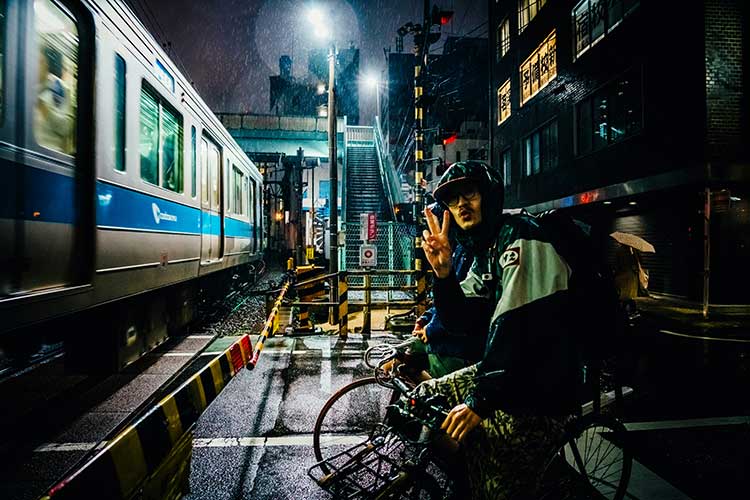There’s something inherently peaceful about cycling through the empty campus after hours as the day’s hustle fades. The quiet streets and the cool night air can make for a refreshing ride back from the library or a late study session.
However, navigating campus roads under the moonlight requires more than just a love for bicycles; it demands a keen awareness of safety and preparedness. You can avoid the need to stay long hours in the library researching or writing your essays altogether if you just delegate all the excessive tasks to paper writing services. Yet, if late-night rides are inevitable for you, let us show you some strategies on how to make your evening cycling both safe and enjoyable.
Equip Your Bike with Proper Lighting
Riding at night without adequate lighting is not only challenging but downright risky. Ensuring your bike is equipped with a strong front light and a red rear light is the first step in making your cycling ventures safer. The front light illuminates your path, helping you spot any potential hazards, while the rear light makes you visible to others on the road.
Consider lights that offer different modes, such as steady, flashing, or pulsing, as these can help increase your visibility depending on the situation. A headlamp worn on your helmet can also enhance your visibility, directing light wherever you’re looking, which is particularly useful at intersections or when navigating around obstacles.
Wear Reflective Clothing
Visibility is your best friend when cycling at night. Wearing dark, non-reflective clothing makes you virtually invisible to motorists and other cyclists. To stand out:
- Opt for a reflective vest or jacket.
- Use reflective tape on your helmet, bike frame, and wheels.
- Wear light-colored clothing.
- Consider reflective arm bands or leg bands.
- Choose gloves and backpacks with reflective elements.
By making these choices, you transform yourself into a moving beacon of light. Reflective clothing acts like a signal flare. This simple change can drastically reduce the risk of accidents, making your night rides much safer.
Plan Your Route in Advance
Knowing where you’re going before you head out can significantly enhance your safety when cycling after dark. Familiarize yourself with the routes that offer well-lit paths and less traffic, even if it means taking a slightly longer way home.
Additionally, campuses often have specific paths designated for cyclists that are not only safer but also more scenic. Exploring these during the day can give you a good idea of what to expect at night, including where you might encounter potential hazards such as potholes or uneven pavement that are harder to spot in the dark.
Stay Alert and Avoid Distractions
Cycling at night requires your full attention. It’s crucial to listen for approaching cars, other cyclists, or pedestrians, as your eyes alone might not always alert you to their presence.
Don’t check your phone or listen to podcasts or music through both earphones. If you must listen to something, use only one earbud to still hear what happens around you. Paying attention to the road and those around you can make a significant difference in reacting promptly to avoid potential dangers.
Photo by Himiway Bikes on Unsplash
Understand Campus Security Features
Many campuses are equipped with emergency phones and well-lit paths designed to keep students, including student cyclists, safe. Being aware of these features can be a big help in case of emergency.
- Locate emergency phone stations along your route.
- Stick to paths that are well-lit and frequently patrolled by campus security.
- Note the location of campus security offices.
- Keep the campus security phone number saved in your phone.
- Be aware of the hours that campus facilities, like bike repair stations, are accessible.
Knowing these details ensures that if you ever feel unsafe or your bike malfunctions, help is never too far away. After familiarizing yourself with these resources, you’ll feel more confident and secure riding at night.
Cycle in Groups When Possible
There’s safety in numbers. Riding with friends or joining a night cycling group on campus can make you more visible and deter potential threats. Plus, cycling with others can turn a mundane commute into a social activity, making it something to look forward to.
If a cycling group doesn’t exist on your campus, consider starting one. It’s a great way to meet fellow cycling enthusiasts and advocate for safer cycling conditions on campus. Together, you can share tips, plan safe routes, and even organize night rides that cater to the student schedule.
Regularly Maintain Your Bike
Regular checks ensure that your brakes, gears, and lights are functioning correctly, which is especially important when riding at night. Do a quick inspection of your bike before each ride.
At least once a semester, consider a more thorough tune-up, either by a campus bike shop, if available, or a local bike mechanic. This maintenance can catch any potential issues before they become dangerous, ensuring your bike is as ready for the night as you are.
Conclusion
Ultimately, cycling at night is not just about getting from point A to point B; it’s an opportunity to embrace the quieter, more serene side of campus life. By equipping yourself with the right knowledge and tools, you ensure that each ride is not only safe but also a pleasurable addition to your college experience. If you want to go on a longer bike ride and try out cycling routes nearby, seeking support from the best essay writing service can give you extra free time to do so. With our guide, you’ll boost your safety and enjoy every ride.
Author Bio
Nicole Hardy, a distinguished journalist in the realms of education and the arts, is celebrated for her thorough and discerning coverage of performing arts education. Her career, which extends beyond ten years, has solidified her status as an authoritative figure in this domain. Hardy is praised for her thorough analyses and captivating writing manner. She earned her Master’s in Journalism from the University of Arts, with a focus on arts, culture journalism and now she provides amazing student friendly content on News.EssayHub.com
Top Photo by Victoriano Izquierdo on Unsplash
No products found.

















